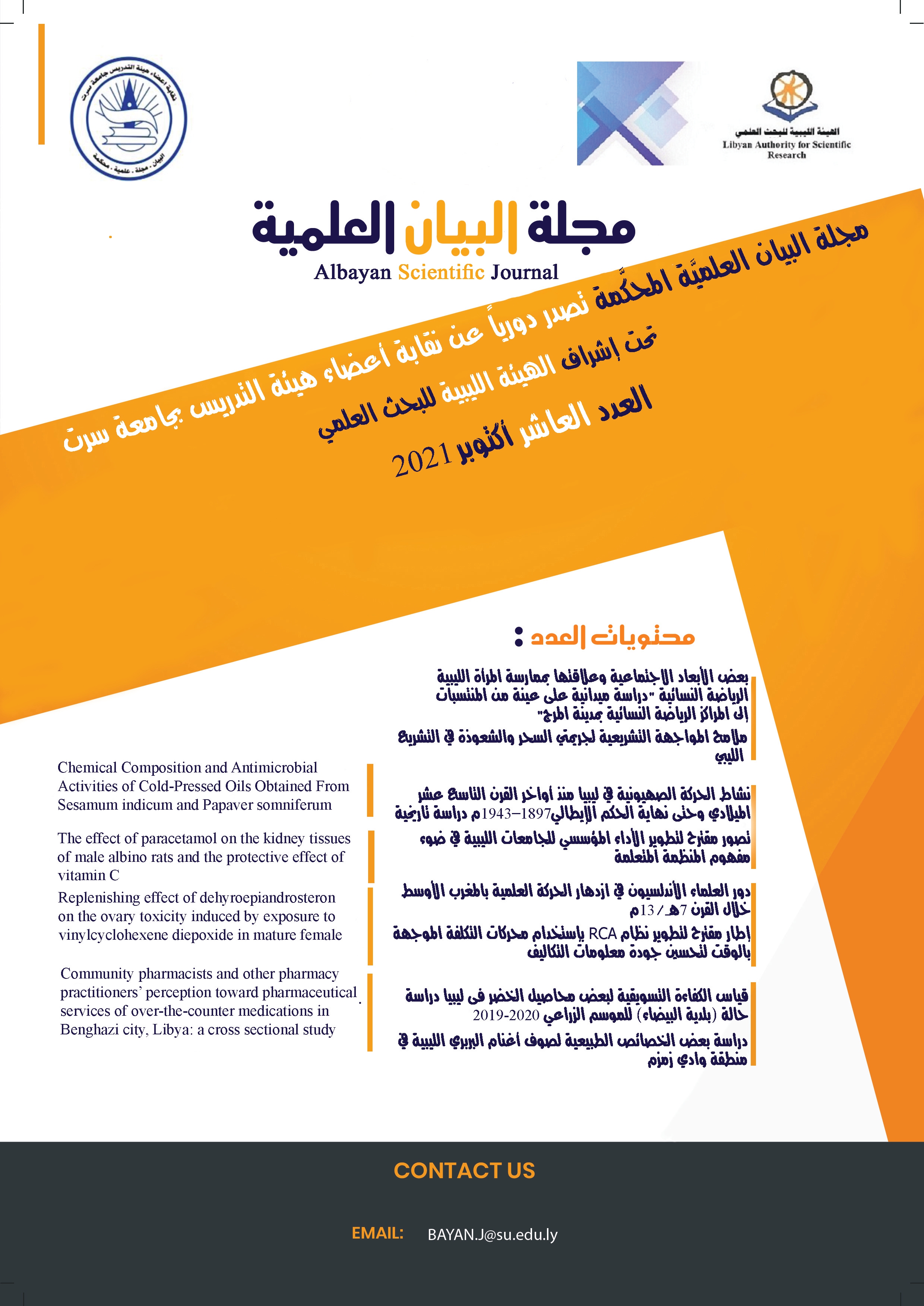Evaluation Of Hepatoprotective Activity Of Aqueous Extract Of Indian Costus Roots On Paracetamol Induced Hepatotoxicity In Albino Mice
DOI:
https://doi.org/10.37375/bsj.vi10.2347Abstract
Indian Costus (Zingiberaceae) is widely employed in various traditional medicines. The present study is aimed at evaluating the hepatoprotective effect of aqueous extract of indian costus roots by paracetamol-induced liver damage in mice. The experimental mice were separated into five groups (n = 7 mice): group-A which kept as normal control group; group-B was treated with paracetamol (14 mg/kg b.w.) as therapeutic doses once a day intraperitoneal (IP) for four days ; group-C was treated with paracetamol (85 mg/kg b.w.) as overdoses once a day by IP administration for four days; ; groups-D and E received orally (10 µl) 10% Indian costus roots extract every day for eight days. On the fifth day , the animals of groups -D and E were treated with paracetamol (14 and 85 mg/kg b.w.) once a day for four days followed by IP administration. At the end of the experimental period, blood was obtained from each maus for the determination of serum levels of aspartate transaminase (AST), alanine transaminase (ALT) and alkaline phosphatase (ALP). Biochemical analysis of the serum obtained showed a significant increase in the levels of AST, ALT and ALP in mice administered with14 mg/kg b.w. and 85 mg/kg b.w of paracetamol. Pre-treatment of the animals with the extract caused a decrease in the levels of these enzymes. In parallel, the histopathological assessments of the liver sections of mice also proved that extract markedly minimized the PA toxicity and maintained the liver tissues.This study has shown that the aqueous extract of indian costus roots a possesses slight hepatoprotective property.
References
: References:
Baiaan H. Al Saadi, Shoaa H. AlHarbi, Sabrin R. M. Ibrahim, Amal A. El-Kholy, Dina S. El-Agamy, and Gamal A. Mohamed(2018): Hepatoprotective activity of Costus Speciosus against Paracetamol -Induced liver Injury in mice : Afr J Tradit Complement A ltern Med., 15 (2): 35-41
Bannwarth B, Pehourcq F 2003: Pharmacologic basis for using paracetamol: pharmacokinetic and pharmacodynamic issues. Drugs. 2003 ;63 Spec No 2:5-13.
Bavarva,J.H. and Narasimhacharya, A. V. (2008). Antihyperglycemic and hypolipidemic effects of Costusspeciosus in alloxan induced diabetic rats. Phytother. Res., 22: 620-626.
Bergmeyer, H.U., M. Horder and R. Rej. (1986a). Approved recommendation on IFCC methods for the measurement of cata-lytic concentration of enzymes. Part II. IFCC method for aspartame aminotransferase. J. Clin Chem. Clin. Biochem. 24: 497-508
Bergmeyer, H.U., M. Horder and R. Rej (1986b). Approved recommendation on IFCC methods for the measurement of cata-lytic concentration of enzymes. Part III. IFCC method for alanine aminotransferase. J. Clin. Chem. Clin. Biochem. 24: 481-495
Boyd EH, Bereczky GM (1966) . Liver necrosis from paracetamol. Br J Pharmacol 1966; 26: 606- 614.
Bhuyan B., Zaman K. 2008. Evaluation of hepatoprotactive activity of rhizomes of Costusspeciosus(J. Konig.) Smith. Pharmacologyonline; (3): 119-126.
Cohen, S.D. and Khairallah, E.A. (1997). Selective protein arylation and acetaminophen-induced hepatotoxicity. Drug Metab. Rev. 29:59-77.
Cranswick N, Coghlan D (2000). Paracetamol efficacy and safety in children: the first 40 years. Am J Ther 7135–141.
Dahlin D, Miwa G, Lu A, Nelson S. Nacetylp- benzoquinone imine (1984): Acytochrome P-450-mediated oxidation product of acetaminophen. Proc
Natl AcadSci ; 81: 1327-1331.
Deni B. Encyclopaedia of Herbs, The Royal Horticulture Society 2008; P: 181.
Devi, V. and Urooj, A. (2010). Nutrient Profile and Antioxidant components of CostusspeciosusSm. and CostusigneusNak. Indian J. Nat. Prod. Resour. 1:116-118.
Ferner RE, Dear JW, Bateman DN. Management of paracetamol poisoning. BMJ. 2011 Apr
19;342:d2218.
Forrest JA, Clements JA, Prescott LF (1982). "Clinical pharmacokinetics of paracetamol". Clin Pharmacokinet. 7 (2): 93–107.
Graham GG, Davies MJ, Day RO, Mohamudally A, Scott KF (2013) :The modern pharmacology of paracetamol: therapeutic actions, mechanism of action, metabolism, toxicity and recent pharmacological findings". Inflammopharmacology. 21 (3): 201–32.
Gupta RK. Medicinal and Aromatic Plants with Colour Plates (2010): Traditional and Commercial Uses Agrotechniques Biodiversity Conservation (HB) ; CBS: 234-499.
Hazai, E., Monostory K., Bakos, A., Zacher, G. and Vereczkey, L. (2001). About hepatotoxicity of paracetamol overdose. Orv. Hetil. 42:345-349.
Kaplowitz N. Idiosyncratic drug hepatotoxicity. Nat Rev Drug Discov 2005; 4: 489-499.
Kulkarni, D. (2011). Acute paracetamol toxicity - A case report. Indian J. Appl. Res. 3:466-468.
Kang, K.S. (2013). Abnormality on liver function test. Pediatr. Gastroenterol. Hepatol. Nutr. 16:225-232.
Lesko S M, Mitchell A A(1999). The safety of acetaminophen and ibuprofen among children younger than two years old. Pediatrics 104e39.
Lijuan, W., Kupittayanant, P., Chudapongse, N., Wray, S. and Kupittayanant, S. (2011). The effects of wild ginger, Costusspeciosus (Koen Smith) rhizome extract and diosgenin on rat uterine contractions. Clin. Pharmac., 10: 2815-2885.
McCloskey P, Edwards RJ, Tootle R, Selden C, Roberts E, Hodgson HJ (1999). Resistance of three immortalized human hepatocyte cell lines to acetaminophen and N-acetylpbenzoquinoneimine toxicity. J Hepatol ; 31: 841-851.
McGill MR, Jaeschke H (2013)."Metabolism and disposition of acetaminophen: recent advances in relation to hepatotoxicity and diagnosis".Pharm Res. 30 (9): 2174–87.
Nahak G, Kantasahu R (2011). Free radical scavenging activity of rhizome of
CostusSpeciosus (KOEN) J. E. SM. Int J Ins Pharm and L Sci 1; 1:62-67.
National Poisons Information Service. TOXBASE. Paracetamol. 2017 [internet publication].
Prescott, L. F. (1980). Kinetics metabolism of paracetamol and phenacetin. Br. J. Clin. Pharmac., 10: 2915-2985.
Rajasekharan. S, Pushpangadan. P and Biju, S.D,1996 .Folk Medicines of Kerala - A Study on Native Traditional Folk Healing Art and its Practitioners in Jain, S.K. (ed) Deep Publications, New Delhi India pp167-172.
Ricciotti E, FitzGerald GA (2011): Prostaglandins and inflammation. Arterioscler Thromb Vasc Biol. May;31(5):986-1000.
Shaw, L.M., J.H. Stromme and J.L. Lon-don. (1983). Approved recommendation on IFCC methods for the measurement of cata-lytic concentrations of enzymes. Part 4. IFCC method for gamma-glutamyl transferase. J. Clin Chem. Clin. Biochem. 21: 636-646
Singh, P., Mishra, G., Khosa, R., Srivastava, S., Jha, K. and Srivastava, S. (2011). Anthelmintic activity of aerial parts of Costus speciosus. Int. J. Green Pharm. 5:325-328
Srivastava, S., Singh, P., Jha, K. K., Mishra, G., Srivastava, S. and Khosa, R. L. (2013). Anti inflammatory, analgesic and antipyretic activities of aerial parts of Costusspeciosus Koen. Indian J. pharm. Sci.,
75: 83-88.
Srivastava, S., Singh, P., Jha, K.K., Mishra, G., Srivastava, S. and Khosa, R.L. (2011). Costusspeciosus (Keukand): A review. Der Pharmacia Sinica. 2:118-128
Sivarajan, V. V. and Balachandran, I. (1994). Ayurvedic drugs and their plant sources. Oxford & IBH Publishing Co. Pvt. Ltd. New Delhi., pp 439.
Tushar, Basak S, Sarma GC, Rangan L. (2010):Ethnomedical uses of Zingiberaceous plants of Northeast India. J Ethnopharmacol. 2010 Oct 28; 132(1):286-96.
Vaishwanar I, Kowale CN (1979). Effect of two ayurvedic drugsShilajeet and Eclinol on changes in liver and serumlipids produced by carbontetrachloride. Ind J Exp
Biol ; 14: 58-61.
Verma, N. and Khosa, R.L. (2009). Evaluation of protective effect of ethanolic extract of Costusspeciosus(Koen.) Sm. rhizomes of carbon tetrachloride induced hepatotoxicity in rats. Nat. Prod. Rad. 8:123-126.
Vermeulen, N.P.E., Bessems, J.G.M. and Vandestreat, R. (1992).Molecular aspects of paracetamol-induced hepatotoxicity and its mechanism-based prevention. Drug Metab. Rev. 24:367-407.
Vijayalakshmi MA, Sarada NC(2008). Screening of Costusspeciosus extracts for antioxidant activity. Fitoterapia ;Nadkarni KM. Indian MateriaMedica. Bombay Popular Prakashan, India, 2009; 385-386. 5. 79: 197-198.














